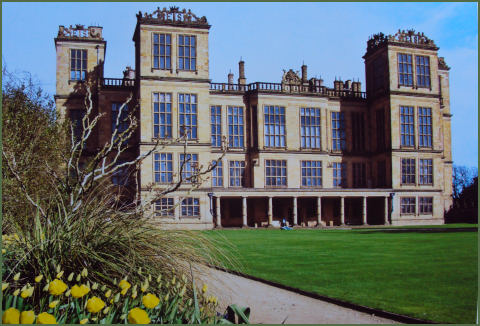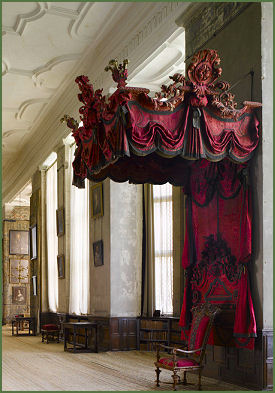Hardwick Hall
Grid Ref: - SK463637
 Hardwick Hall, situated near Chesterfield in the Peak District National Park is one of the most significant Elizabethan country houses in England.
Hardwick Hall, situated near Chesterfield in the Peak District National Park is one of the most significant Elizabethan country houses in England.
The house was constructed during the reign of Queen Elizabeth I for the formidable and astute Bess of Hardwick, Countess of Shrewsbury, who became the ancestress of the Dukes of Devonshire.
Bess acquired Hardwick Old Hall after the former owner her brother died. Following a heated quarrel with her husband, she moved into the hall alone and succeeded in transforming it into one of the greatest Elizabethan mansions in the country. The new hall which she built on the estate was so splendid that it is considered to be one of the finest buildings of the period in Europe. After the Queen, Bess was the richest woman in England and Hardwick Hall reflects this fabled wealth. Overtly proud of the fact that she had acquired the 'Shrewsbury' title, Bess adorned the new Hardwick Hall, almost symbolically, with her initials 'ES'.
Bess rose from humble origins to become one of the most powerful people in the court of Queen Elizabeth I. She was married four times, each time gaining more wealth, her fourth husband was the Earl of Shrewsbury, one of the richest and most powerful of the English nobles of the time.
 A statue of Mary Queen of Scots graces the entrance hall, tradition states that Mary visited the hall, the Queen of Scots was a prisoner in the charge of the Earl of Shrewsbury. A grand and elaborate winding, stone staircase leads up to a suite of state rooms which are housed on the second floor, plaster friezes and alabaster fireplaces colour the rooms, culminating in the atmospheric Long Gallery, one of the largest long galleries in any English house.
A statue of Mary Queen of Scots graces the entrance hall, tradition states that Mary visited the hall, the Queen of Scots was a prisoner in the charge of the Earl of Shrewsbury. A grand and elaborate winding, stone staircase leads up to a suite of state rooms which are housed on the second floor, plaster friezes and alabaster fireplaces colour the rooms, culminating in the atmospheric Long Gallery, one of the largest long galleries in any English house.
Most of the large fashionable Tudor houses possessed long galleries, which were often used to exercise in whenever the weather was too inclement to venture outside. There is also a splendid and little-altered, tapestry-hung great chamber with a spectacular plaster frieze of hunting scenes. The windows are extremely large and numerous for the sixteenth century and were a powerful statement of wealth at a time when glass was considered a luxury, leading to the saying, "Hardwick Hall, more glass than wall".
The hall contains a fine collection of fine tapestry, furniture and paintings dating from the sixteenth and seventeenth centuries. There is also a large collection of embroideries, mostly dating from the late sixteenth century. Some of the needlework which is displayed at Hardwick bears Bess' monogram "ES" (Elizabeth Shewsbury), and is reputed to have been worked by Bess of Hardwick herself. A bed claimed to be that of Mary, Queen of Scots, bears her arms as Queen of Scotland and Dowager of France over the door, and her initials worked into the tapestry.
Hardwick Hall is surrounded by fine gardens, which include herbaceous borders, a vegetable and herb garden, and an orchard.
The house stands within an impressive country park containing rare breeds of cattle. Hardwick Old Hall stands in the grounds, dating from the fourteenth century, it was used as guest and service accommodation after the new hall was built. The Old Hall is now a ruin, although visitors can still ascend four floors to view surviving decorative plasterwork. It is administered by English Heritage on behalf of the National Trust.
New this year is the Stableyard project, due for completion in spring 2012, aimed at changing the visitor experience at Hardwick. Disused estate buildings have been given a facelift and will now be home to a new shop, restaurant and visitor reception building
